Reckoning with Millet’s Man with a Hoe, 1863–1900
Reviewed by Lynne D. AmbrosiniLynne D. Ambrosini
Deputy Director/Chief Curator Emerita, Taft Museum of Art and Independent Scholar/Curator
Email the author: orbma12[at]gmail.com
Citation: Lynne D. Ambrosini, exhibition review of Reckoning with Millet’s Man with a Hoe, 1863–1900, Nineteenth-Century Art Worldwide 23, no. 1 (Spring 2024), https://doi.org/10.29411/ncaw.2024.23.1.15.
This work is licensed under a Creative Commons Attribution-NonCommercial 4.0 International License  unless otherwise noted.
unless otherwise noted.
Your browser will either open the file, download it to a folder, or display a dialog with options.

Reckoning with Millet’s “Man with a Hoe,” 1863–1900
J. Paul Getty Museum, Los Angeles
September 12–December 10, 2023
Associated book:
Scott Allan, ed.,
Reckoning with Millet’s “Man with a Hoe,” 1863–1900.
Los Angeles: J. Paul Getty Museum, Getty Publications, 2023.
124 pp.; 52 color and 6 b&w illus.; endnotes; bibliography; index.
$26.95 (softcover)
ISBN: 9781606068557
Finding an Audience: Nineteenth-Century Drawings
J. Paul Getty Museum, Los Angeles
September 26, 2023–January 7, 2024
In the past twenty years or so, interest in the impressionists’ immediate predecessors has surged on both sides of the Atlantic, and Jean-François Millet (1814–75) studies have benefited.[1] Among exhibitions alone, and only considering the last five years, a large-scale Millet show supported by the Réunion des Musées Nationaux graced Lille’s Palais des Beaux-Arts in 2017–18. Three years later, Simon Kelly and Maite van Dijk explored the painter’s influence on later artists in an exhibition organized for the Saint Louis Art Museum and the Van Gogh Museum in Amsterdam.[2] The small but exemplary exhibition reviewed here, Reckoning with Millet’s “Man with a Hoe,” 1863–1900, which appeared synchronously with an associated book, forms the latest instance of this trend.
This was essentially a focus show, and one with a singular focus: the reception of the Getty Museum’s Man with a Hoe, a masterpiece of nineteenth-century painting (fig. 1). Typically, dossier exhibitions are relatively diminutive, devoting a wall or two to presenting in-depth information about a cherished museum object. They often foreground topics like provenance, conservation history, or artistic process. The Getty exhibition offered instead a deep dive into the reputation of a picture over a half-century in both France and the United States (fig. 2). In a spacious gallery divided into seven separate sections appeared almost thirty works in a variety of media, including oil paintings, drawings, prints, and books. All elucidated one topic, the critical and popular reactions to—and ultimately the meaning of—a single troubling painting.
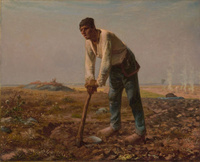
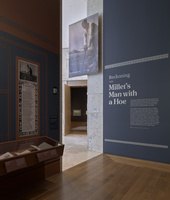
Given the Man with a Hoe’s status as the most intensely controversial picture in the artist’s career, visitors might have expected to learn, too, about its origins: how did Millet conceive and shape such a powerful image? After all, he worked on the painting for almost two years and had been studying the motif for some fifteen years. His process of creation for major works involved sketches from life, followed by drawings intended to refine a pose or clarify a composition. The Getty exhibition did include a couple of early etchings of peasants digging—the general theme—and, importantly, a highly finished related drawing, conveniently owned by the museum (fig. 3). Its appearance here allowed instructive comparisons with the final canvas. Should more of the preparatory drawings, which do appear in the accompanying book, have been added to the exhibition? In all fairness, however, the locations of only four are known, they are aesthetically slight, and even an exhaustive search would not have guaranteed finding others. Moreover, the exhibition’s single-minded concentration on reception history yielded distinct rewards.
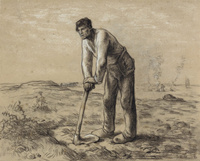
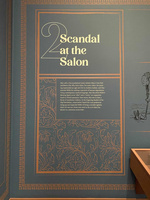
This began with its creative visual conception. Collaborating closely, curator Scott Allan and exhibition designer Alan Konishi riffed on nineteenth-century book design, treating each wall as a page, each complete with a numbered chapter heading and ornamental margins, with their motifs cleverly extracted from historical Millet-related publications (fig. 4). Elaborate exhibition treatments risk heavy-handedness, but this one seemed felicitous: the stenciled borders tightly unified the exhibition, reduced the verticality of walls that housed only small prints or cases, and subliminally called attention to the preponderant role of published documents in shaping responses to the painting, an ancillary theme of the show. Fortunately, too, the staff had the good sense to abjure decoration on the wall featuring the Getty’s magisterial painting itself. Throughout the space, a palette of slate blue and Indian red, supplemented by stylish reverse-color typography for wall texts—blue on red and red on blue—pleasantly evoked a nineteenth-century interior.
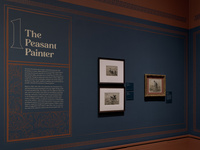
Seven numbered exhibition “chapters,” or sections, opened with “1. The Peasant Painter,” which introduced Millet and briefly covered the artist’s essential life-project: depicting the daily lives of French peasants as he knew them from his youth in Normandy and his home in the village of Barbizon (fig. 5). Loans of some of his etchings of agricultural labors enriched this section.
Each of the six successive portions focused more narrowly on the Man with a Hoe. That Getty moniker, incidentally, is based purely on convention; Millet gave as the official Salon title: Un paysan se reposant sur sa houe (A Peasant Resting on his Hoe).[3] Revealingly, this real title rarely appears in the standard literature, even in such authoritative texts as the Louvre exhibition catalogue of 1975;[4] the picture’s fame accrued to the conventional name, and its fame soon eclipsed everything else about it.
Trying to see Millet’s painting afresh, we register an image of utter human exhaustion, a man pausing from work with a tool (the short hoe) so physically demanding that one like it, “el brazo del diablo” (“the devil’s arm”) was finally banned in California in 1975 after massive protests (9). French agricultural manuals record that this peasant’s task, turning over rocky, densely compacted earth prior to planting, was recognized as cruelly punishing.[5] Resting a moment, his limbs stiffened to hold him from collapse and mouth agape to draw breath, the figure stares unseeingly ahead.
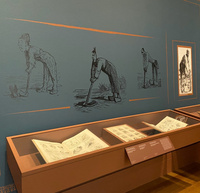
The second section of the exhibition, “Scandal at the Salon,” describes the contentious debates over the painting in 1863 (fig. 6). Why did it strike such a nerve? The French bourgeoisie still lived in fear of a recurrence of age-old, violent peasant rebellions. Where now we notice the picture’s earthy and harmonized palette of ochres, soft rose, and pale blue, its modeling in deft touches that ally the figure to the soil, and the lack of particularity in the features—a deliberate move by Millet to generalize his statement—most critics at the Salon saw something else. They attacked the picture for its presumed political threat, “ugliness,” depiction of a “criminal” or “cretin,” and anti-academic approach. At the Getty, a group of searing contemporary caricatures, easily legible in enlarged wall reproductions, proved the truth of the adage about pictures and their worth relative to words. Meanwhile, Millet’s far less numerous supporters defended his sincerity, originality, and concern for the poor.
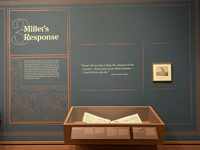
The next section, “Millet’s Response,” told of the painter’s efforts to wrest back control of his picture’s interpretation, which proved as ineffective then as attempting to recall a popular internet meme today (fig. 7). In three important letters (of May 30, June 2, and August 1863), two of which were soon published, Millet explained himself. He refuted the political charges, speaking instead of the Bible: the poor would always suffer, he said, alluding to a favorite verse from the book of Genesis (3:19): “in the sweat of thy face shalt thou eat bread.” Denying that his painting was ugly, he urged a grander conception of beauty in art that encompassed the entire natural world and all its creatures, however humble. Privately, Millet worried that the Hoe, tainted by controversy, might not sell, but a dealer managed to place it in a Belgian collection the following year.
An important exhibition loan, a rare 1863 albumen print after the Salon canvas by pioneering art photographer Robert J. Bingham (1824–70), demonstrated one way that Millet attempted to steer public opinion of his painting. To the image, Millet attached his own preferred gloss, a passage by the sixteenth-century French essayist Michel Montaigne (1533–92) on the admirable perseverance of peasants despite their misery. The Bingham photo lent here traveled from the tiny Musée Millet in the village of Barbizon, France, attesting to noteworthy curatorial ferreting.
The fourth section, “Posthumous Acclaim,” dealt with the improvement in Millet’s—and the canvas’s—reputation and monetary value following the Hoe’s resurfacing on the French art market in 1881 (fig. 8). Each of the several times it changed hands over the next decade, its price soared. The most significant loan in this section, Millet’s Shepherdess with Her Flock from the Musée d’Orsay, contrasts tellingly with the more difficult Getty painting. Exhibited in 1864, this pastoral image of la vieille France earned Millet his first top-tier medal from the Salon jury. The demurely pretty sheep-minder was everything that the haggard, brutalized Man with a Hoe was not. Its presence here also permitted a reunion with the Getty’s own pastel drawing of the subject, a handsome sheet that raised questions—unanswerable within the limits of this exhibition—about the relationship between Millet’s canvases and related graphic works (fig. 9).[6] The placement of the last two works made me wonder about alternative gallery layouts, as these fruits of his maturity hung uncomfortably on a wall labeled “Posthumous Acclaim.” However, Allan justifiably employed them to introduce the shift in Millet’s reputation that began in the year of their making, 1864.
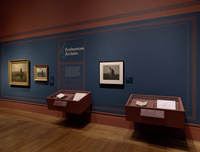
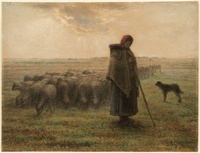
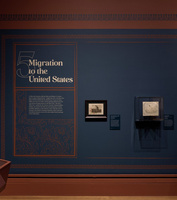
Section Five, “Migration to the United States,” chronicled the painting’s purchase by California railroad heirs Ethel Sperry Crocker (1863–1934) and William H. Crocker (1861–1937) in Paris in 1890 (fig. 10). At home in their San Francisco mansion, it shone as the gem of their collection. They lent it to local charity exhibitions and then allowed its much-praised display at the 1893 World’s Columbian Exposition in Chicago. Millet’s posthumous celebrity in both Europe and the Americas then stood at its acme.
The inclusion of prints and illustrated books reinforced the theme of this section, as with the others. Given the nineteenth-century vogue for illustration and its renaissance of etching, such objects brought both aesthetic and documentary value. Besides the Getty itself, the Getty Research Institute, and the Musée d’Orsay, lenders included the Los Angeles County Museum of Art, Balch Art Research Library, and private collectors.
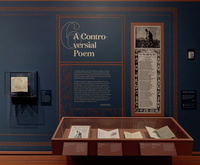
A sixth section, “A Controversial Poem,” centered the verses that Edwin Markham (1852–1940), a teacher and poet from Oakland, composed in 1899 (fig. 11). At one time, every child in the US could recite at least its first stanza by heart:
Bowed by the weight of centuries he leans
Upon his hoe and gazes on the ground,
The emptiness of ages in his face,
And on his back the burden of the world.
Who made him dead to rapture and despair,
A thing that grieves not and that never hopes,
Stolid and stunned, a brother to the ox?
Who loosened and let down this brutal jaw?
Whose was the hand that slanted back this brow?
Oh masters, lords, and rulers in all lands,
Is this the handiwork you give to God,
This monstrous thing distorted and soul-quenched?
Blaming wealthy business owners and landowners for the afflictions of the working poor, the polemical poem appeared in the San Francisco Examiner alongside an illustration of the painting. Its import was easily grasped at the Getty, where it materialized as a handily enlarged wall-reproduction. Rapidly taken up by newspapers all over the country, Markham’s poem instantly popularized Millet’s work but also merged with it in the national consciousness, as the exhibition’s accompanying book explores more fully.
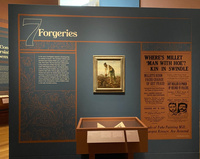
The last section, “Forgeries,” concerned a group of faux Millets created in France in the 1930s (fig. 12). Jean-Charles Millet (1892–1944), a grandson of the artist, launched the hoax with a retired house-painter, Paul Cazot, for the usual reasons. Holding pride of place in this section was an unusual loan from a private collection: a forged “study” for Man with a Hoe. It dated from before 1925, when the British art dealer and specialist in Barbizon pictures David Croal Thomson (1855–1930), taken in by the swindle, published it as a preparatory study for the Getty painting. Here, for the first time, the public could compare the false Millet to the real.
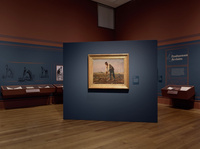
Overall, the exhibition presented well-chosen loans and groupings and a coherent narrative; visitors had only to track the unidirectional path indicated by the numbered “chapters.” Didactic texts avoided the twin perils of inadequate information and overwhelming excess. Most of the seven section summaries consisted of one or two fluently written paragraphs, nicely hitting the key points, while brief individual object texts offered illumination on political and social context. It is an all-too-rare relief to visit a museum whose staff respects the intelligence of visitors, addressing them with neither jargon nor condescension. The Getty also furnished a free audio tour and foreign language translations on its GettyGuide app. All in all, the staff earned an A+ for best practices in exhibition pedagogy (fig. 13). Only one possible improvement to the exhibition comes to mind: the valuable material published in the accompanying book about racialized readings of Millet in the United States did not make it into the gallery space, and, in our post-George Floyd era, arguably should have.
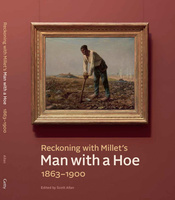
Beautiful catalogues, of course, offer the only enduring consolation for the sad evanescence of temporary exhibitions. The Getty Publications book that was timed to appear with this exhibition affords many pleasures. Its handsome design naturally seizes the attention first; its front cover reproduces the eponymous painting in its handsome nineteenth-century French frame (fig. 14). Measuring 7 1⁄4 by 8 5⁄8 inches, the softbound volume conforms to a conveniently carried format that the publishing house has used previously for other books focused on single works. The fine color plates evidently received conscientious scrutiny for accuracy of hue, as they admirably keep faith with the originals. Page-spread design pays homage first and foremost to simplicity and legibility, while the sans serif font—the very clean Alright Normal by Okay Type—follows suit. Although this reader, for one, may sigh for the distant past when convenient footnotes required no flipping of pages, the endnotes here at least follow directly after each essay rather than occasioning a frustrating search through the entirety of a volume’s back matter. A bibliography of frequently cited sources is printed in typography large enough to read, and happily there is a good index.
On the much shorter negative side of the ledger, the book lacks an exhibition checklist. While, granted, this stemmed from a deliberate publishing decision to treat the title as a stand-alone product, the net effect is to devalue exhibition documentation. Curators must object. Further, a chronology of events—gestation, exhibition history, and fiery afterlife of Millet’s picture—might have proven a useful addition, capturing for readers the itinerary so clearly mapped by the physical exhibition. Finally, the absorbing material about the Millet forgery scheme does not, unfortunately, appear in the text at all. Grant indulgence on this point, however: alluring finds—such as the faux study—often surface too late in an exhibition’s planning process for their inclusion in its catalogue, as manuscripts must usually be submitted as much as a year before opening day.
The book’s organization conforms to the order of the exhibition proper, tracing the chronology of the work’s creation, initial display, and subsequent flares of celebrity and contention. First, the editor Scott Allan authors a graceful introductory essay describing the painting, detailing its acquisition by the Getty, and outlining the scope of the book. He also ably demonstrates the ubiquity of the image in France and the United States through mass market parlor reproductions and, eventually and amusingly, in advertising. Finally, he previews what I take as the book’s fundamental point: ambitiously, Millet aimed simultaneously at a stark realism in his depiction of peasant travails and a timeless portrait of Christian stoicism. The inherent contradictions in this dual goal help to account for the broad spectrum of conflicting readings that the picture eventually bore. How a single painting could, and did, fan the flames of both socialist-leaning pro-labor movements and apologists for unrestricted laissez-faire capitalism is the overarching—and often riveting—subject of this volume.
Three longer essays follow the introduction. In the first, Simon Kelly initially investigates the inception of Millet’s picture, analyzing several preparatory drawings. He also reviews literary sources that inspired Millet, such as the fables of Jean de la Fontaine (1621–95) and George Sand’s (1804–76) novel La Mare au diable (The Devil’s Pool; 1846), and Millet’s artistic models, earlier painters who had endowed peasants with dignity, such as Pieter Bruegel the Elder (ca. 1525–69) and the recently-rediscovered seventeenth-century Le Nain brothers. Digesting rather than mimicking earlier art, Millet created portrayals of peasants that diverged notably from those of contemporaries, a few of which Kelly illustrates.
Finally, the essayist turns his attention to his real subject; his piece bears the title “‘The Epic of Labor’: Millet’s Man with a Hoe at the 1863 Salon.” Tackling the fraught debut of Millet’s painting, and fully exploiting the opportunity offered by a single-painting publication, Kelly disentangles the strands of overlapping, conflicting, and frequently vociferous reactions from journalists—both those sympathetic to Millet, such as the left-wing Théophile Thoré-Bürger (1807–69) and Théodore Pelloquet (1820–68), and his detractors, supporters of academic art like Paul de Saint-Victor (1827–81) and Charles-Olivier Merson (1846–1920). Kelly draws on the extensive published correspondence between Millet and his agent and friend Alfred Sensier (1815–77) as a lens through which to investigate the painter’s aims. Indeed, the chief advantage that both Kelly and Allan have over earlier writers is the publication, in 2005, of Millet’s complete correspondence.[7] The duration and continuity of Millet’s and Sensier’s communications affords us a very rare opportunity: it opens a wide archival window into how a nineteenth-century French artist apprehended and sought to rebut published criticism.
Like the two other authors, Kelly draws upon earlier scholars’ foundational work on the Hoe’s reception, particularly that of Robert L. Herbert, but enlarges our understanding of the issue.[8] He also presents four interesting nineteenth-century responses to the painting that have not been published elsewhere. In all, he thoughtfully considers an impressive nineteen contemporary critiques, integrating his discussion of them with an analysis of Millet’s three letters. Kelly’s major contribution lies in his new and well-supported emphasis on how the artist himself took an active role in the drama, “inserting himself” into the critical debate.
Indeed, what impresses today’s reader, given Millet’s letter-writing campaign, is how much the canvas must have mattered to him. He seemed pleased that left-leaning defenders lauded the candor of his subject, but less happy when they interpreted it as subversive of the existing social order. Meanwhile, the very image of such an imposingly fatigued figure appears to have struck mainstream and reactionary coevals like a blow. Before the Salon, sensing the impending storm, Millet had privately predicted, “How I shall be attacked!” and once the downpour had begun, acknowledged to a supporter that he was “disturbing the fortunate in their rest” (20, 36). If Millet was an activist, as Kelly convincingly argues, he nonetheless remained in an important sense closeted, because he never publicly took a political stance. Perhaps, ambivalent about the full implications of his radical picture, he was not fully “out” to himself.
The second essay, Scott Allan’s “From Toxic Asset to Trophy Picture: The Fortunes of Man with a Hoe, 1863–90,” picks up the painting’s story where Kelly leaves off. Allan begins with its fortunes in 1864, when it sold to a broker in Brussels. The writer then adroitly interweaves the history of the picture’s ownership with an account of Millet’s changing critical fortunes, particularly the virtual “apotheosis” after his death in 1875. The return of the Man with a Hoe to Paris in 1881, when it sold to the dealer Georges Petit (1856–1920), allowed it to participate in a new cultural moment: at that time, officially-endorsed ideology promoted under the early Third French Republic (1870–1940) newly heroized the French peasantry and Millet alike.[9] Aided by the fact that Sensier’s adulatory biography of the artist appeared in the very same year that Petit triumphantly put the painting on view in his gallery, 1881, the Man with a Hoe suddenly looked like an authentic, compassionate masterpiece.
In a heady period over the next decade, the Hoe sold and resold, escalating dramatically in price in tandem with the booming late nineteenth-century market for Barbizon paintings. Allan supplies insights into each patron, dealer, and transaction in this sequence, disclosing a few previously unknown links in the chain of provenance. By the time of the picture’s inclusion in the Millet retrospective at the École des Beaux-Arts of 1887, all the publicity and even the earlier scandal of 1863 had only boosted the celebrity and market value of the canvas, as the essayist perceptively notes. When Paul Durand-Ruel (1831–1922) handed over the canvas to Ethel Crocker in 1890 for 340,000 francs, the price—had it been widely known—would have seemed astronomical.
The final essay, John Ott’s “Westward Hoe! Evolution, Eugenics, and the Reception of Millet in the United States,” examines the reception of Millet’s painting after its arrival in California in 1891. An Americanist, Ott digs deep into the intense national disputes elicited by the canvas and especially by Markham’s poem. He skillfully connects those to the then-heated “labor question” and to a timely issue today, US race relations. His essay expands a segment from an earlier book he wrote, which examined the patronage of Central Pacific Railroad executives—including the Crockers—as a means of molding culture and opinions for their own benefit.[10] Now he has probed more deeply into how ideas of heredity, eugenics, and racial difference modulated responses to Millet’s painting. The scholar Laura Meixner covered this territory first, as Ott rightly acknowledges, but whereas she examined a wealth of issues elicited by the picture and related poem, including philanthropy, tax reform, corporate monopoly, trusts, and race, Ott focuses squarely and more comprehensively on the last, adding a great deal to the story.[11]
Markham had made clear that the oppression decried in his poem about Millet applied to industrial workers as much as farmhands. Progressives denouncing the abominable conditions in the nation’s then-unregulated factories, conditions that many wrongly believed exerted a malignant heritable influence, could thus refer to Millet’s picture as evidence. At the same time, conservatives who dreaded rising immigration and approved of segregation, which the Supreme Court had ratified in 1896, saw in Millet’s peasant the abhorrent “other.” Taking the social Darwinist perspective, the prominent railroad founder Collis Huntington (1821–1900) (partner of William Crocker’s father) upheld the view that, rightfully, the “fittest” (the most industrious and moral) would succeed while the lazy and vicious would fail, in a natural selection process that would beneficially weed out “degenerate” humans like Millet’s “Hoeman.” Plumbing the resource of digitized period newspapers, Ott has discovered a rich vein of (previously uncited) published arguments over the painting. These egregiously racist and classist letters to the editors of national newspapers make gripping—if excruciating—reading.
Early twentieth-century Neo-Darwinists discerned in Millet’s “brutish” figure—his short, slanting forehead, broad nose, thick neck, and protruding ears—evidence of a “bestial inheritance” and underlying genetic inferiority. The scientist and president of Stanford University David Starr Jordan (1851–1931) opined that unsuccessful types like Millet’s peasant remained at the evolutionary level of a “primitive.” You can see exactly where this is heading: as some eugenicists advocated for “eliminating bad blood” by preventing “breeding” of such figures as Millet’s, others found apish resemblances between the French painter’s “dullard” and criminals and “Negroes,” all wrongly deemed biologically lesser. Ugh. If it is painful to read Ott’s essay, it is nonetheless salutary to realize again how deeply embedded racism is in our history, permeating interpretations of a painting whose French creator certainly never meant it as a registry of racial difference. In sum, Ott compellingly unveils the degree to which arguments over Millet’s painting in the United States depended on repugnant racist assumptions.
This collection of incisive essays now constitutes the definitive commentary on Millet’s picture; it’s hard to imagine—barring the discovery of new documents—that more could be said. The book sheds new light by more fully scrutinizing Millet’s intentions, researching new corners of the nineteenth-century market for his work, and pointing out the prejudices that must be surfaced to unearth the full meaning of his paintings, and any piece of art, in a real-world context. In these ways, Reckoning with Millet’s Man with a Hoe provides a model of what highly focused research can accomplish and delivers a value that belies its seemingly restricted scope.
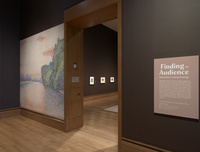
“Finding an Audience: Nineteenth-Century Drawings,” offered Getty visitors exiting the Millet exhibition a dollop of light-hearted icing on the cake (fig. 15). Two large galleries brimmed with stellar works on paper, treating us to pure eye-candy after the intellectual demands of considering Millet’s challenging picture. If you are thinking black and white, think again: color was everywhere, supplied by tinted papers, watercolors, gouache, colored chalks, and pastels. These sheets satisfied as only great nineteenth-century drawings can, coming from what is rapidly becoming one of the world’s premier repositories of such treasures, the Getty vaults. Senior curator and evident connoisseur of drawings Julian Brooks installed them capably.
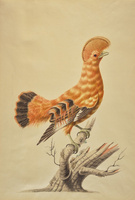
A group of late eighteenth- through early nineteenth-century British examples constituted the first highlight, befitting that period of great creativity in draftsmanship. Among them, a fully elaborated early topographical watercolor, Conway Castle, North Wales (1798), by J. W. M. Turner (1775–1851) displayed his brilliant use of blotting techniques. As if demonstrating the next step in the deployment of watercolors, in which broader brushstrokes and the reservation of more white paper unleashed greater luminosity, Riva degli Schiavoni . . . Venice (1826) offered everything one could possibly want from Richard Parkes Bonington (1802–28). Points go to the Getty for securing works by a female artist from this early period: two vividly colored ornithological watercolors by the self-taught Sarah Stone (ca. 1760–1844; fig. 16).
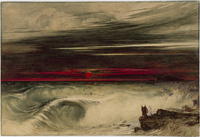
Romantic drawings from both sides of the Channel, another high point of the show, abounded and dazzled. Théodore Géricault’s (1791–1824) watercolor and graphite Giaour of about 1822 afforded a note of splendidly turbulent romantic action to the installation. As if competing with him, Eugène Delacroix (1798–1863) topped one Byronic reference with another in his Death of Lara (ca. 1824), a watercolor scene of mournful tragedy. Matching the literary chops of the French, Samuel Palmer (1805–81) drew upon Spenser’s Faerie Queene (ca. 1590) in Sir Guyon . . . Tempted by Phaedria (1849), an imaginary vision of an enchanted island at sunset composed of remarkably delicate, aqueous brush-tip touches. A mystical watercolor view of Stonehenge at twilight (ca. 1840) by William Turner of Oxford (1789–1862) also attracted the eye. Not to be outdone, John Martin (1789–1854) pulled out all the stops in The Destruction of Pharaoh’s Host (1836), a Biblically-inspired exhibition piece (and media smorgasbord) in watercolor, ink, and oil paint. The artist applied these with verve and abundant scraping-out, while daringly simplifying his color to heighten the drama (fig. 17).
From later in the century, a charcoal, chalk, and gouache landscape by Adolphe Appian (1818–98) masterfully represented French realism of the 1850s; his Forest Landscape near a Pond (1853) came to compelling life through scratching, stumping, and dry brush work. Also working under the Second Empire, fellow-landscapist Maxime Lalanne (1827–86) rendered a Castle Overlooking a River (ca. 1860–79) in virtuoso charcoal, an ideal medium for outdoor work, deployed brilliantly to simulate both aerial transparency and the delicate tonal diversity of foliage.
In an altogether different vein, a Rococo-revival costume piece by Eugène Lami (1800–90), A Couple Embracing in an Artist’s Studio (1881), manifests the dazzling watercolor technique and intense hues of this underrated petit maître. A fellow devoté of parlor interiors, Alfred Stevens (1823–1906) created an intriguing bit of illusionism in watercolor that mimics an artist’s studio pin-up board, confusingly titled A Trompe l’oeil Collage (ca. 1890)—it is not a collage—in which faux landscape sketches keep company with faux figure studies. From the highly original Gustave Moreau (1826–98), who was infatuated with tales of violence, there was a much-too-lovely watercolor of a Greek myth about dismemberment, Diomedes Devoured by Horses (1866).
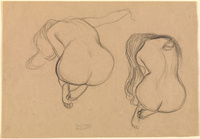
At the close of the century, After the Bath (ca. 1895) by Edgar Degas (1834–1917) displayed his knack for audaciously composed keyhole glimpses of female privacy; this knock-out example boasts an unusually dense layering of color and pattern. A contrasting vision of nudity, as highly eroticized backside, appeared in Gustav Klimt’s (1862–1918) exquisitely sinuous and synthesized chalk-and-pencil line studies (ca. 1901) for the painting Goldfish in the Kunstmuseum Solothurn, Switzerland (fig. 18). A circus scene in colored chalks, Entering the Ring (1899), by Henri de Toulouse-Lautrec (1864–1901), completed this trio of fin-de-siècle master drawings. Finally, a crowd-pleasing pointillist watercolor, The Banks of the Marne at Dawn (ca. 1888) by Albert Dubois-Pillet (1846–90), capped off the exhibition; this landscape flattened by pastel dots and short dashes looks ahead to fauve abstractions. Among the visitor amenities offered by the museum was a commendable Spanish-language translation of all the wall texts, an outreach effort to the large Latinx population of the region. And the Getty’s speedy online collection database makes looking up images of most of the drawings described here remarkably easy https://www.getty.edu/art/collection/.
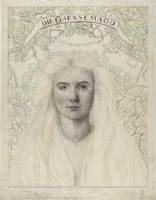
We pass from dessert to the mignardises: a last small space housing three new acquisitions, all admirable, plus a fourth work from the collection to make a quartet. Channeling Botticelli, Armand Point (1860–1932) rendered a profile portrait of his muse and companion, Hélène Linder, in black chalk on green paper and called it Reverie (1895). A large study in opaque watercolor for Perseus (ca. 1882), a figure clothed in illusionistic, shining armor who dynamically springs into flight, showed Edward Burne-Jones (1833–98) at his best; many of us, perhaps, prefer his studies to the more static finished works. The third impressive acquisition—delightful to encounter in a North American museum—came from an artist little known here, but then, many extraordinarily talented female artists remain relatively unknown: the Austrian Emilie Mediz-Pelikan (1861–1908). She is familiar to her compatriots for her accomplished landscapes, but this atypical pencil and colored crayon drawing drew inspiration instead from a fairy tale by the brothers Grimm (fig. 19). Suggesting a revival of late Nazarene romanticism, it evinces a graphism of extreme refinement. The truly last sweet bite came in the form of a 2009 acquisition in black chalk, Klimt’s Portrait of a Young Woman Reclining (1898), in its original Wiener Werkstäate frame, no less. Ah, what money can buy, when applied wisely!
Notes
[1] Research from international scholars was captured in: Lucien Lepoittevin, Jean-François Millet: Au delà de l’Angélus: Colloque de Cerisy sous la direction de Geneviève Lacambre (Paris: Editions Jean-Pierre de Monza, 2002). Besides Millet, Rousseau and Daubigny have received attention. Citing only books, on the former, in chronological order: Greg Thomas, Art and Ecology in Nineteenth-Century France: The Landscapes of Théodore Rousseau (Princeton: Princeton University Press, 2000); Rolande and Pierre Miquel, Théodore Rousseau 1812–1867 (Paris: Somogy Editions d’Art, 2010); Amy Kurlander et al., The Untamed Landscape; Théodore Rousseau and the Path to Barbizon, exh. cat. (New York: The Morgan Library, 2014); Scott Allan and Edouard Kopp, Unruly Nature: The Landscapes of Théodore Rousseau, exh. cat. (Los Angeles: J. Paul Getty Museum, 2016); and Simon Kelly, Théodore Rousseau and the Rise of the Modern Art Market (London: Bloomsbury Publishing, 2023). On Daubigny: Lynne Ambrosini et al., Daubigny, Monet, Van Gogh: Impressions of Landscape, exh. cat. (Edinburgh: National Galleries of Scotland, 2016); Viktoria von der Brüggen et al., Les couleurs de la mer; Charles-François et Karl Daubigny en Normandie, exh. cat. (Honfleur: Musée Eugène Boudin, 2020).
[2] Chantal Georgel et al., Millet, exh. cat. (Lille: Palais des Beaux-Arts and Réunion des musées nationaux, 2017); Simon Kelly and Maite van Dijk, eds., Millet and Modern Art, exh. cat. (New Haven: Yale University Press, 2019).
[3] Explication des ouvrages de peinture, . . . exposés au Palais des Champs-Elysées, le 1er Mai 1863 (Paris: Charles de Mourgues, 1863), 9, cat. 1327.
[4] Robert L. Herbert et al., Jean-François Millet, exh. cat. (Paris: Editions des Musées Nationaux, 1975), “l’homme à la houe,” 27.
[5] Chantal Georgel, Millet (Paris: Citadelles & Mazenod, 2014), 325, 387n41.
[6] On this topic, see Alexandra Murphy et al., Jean-François Millet: Drawn into the Light, exh. cat (Williamstown: Sterling and Francine Clark Art Institute and New Haven: Yale University Press, 1999), 25–27, 96.
[7] Lucien Lepoittevin, ed., Une chronique de l’amitié: Correspondance intégrale du peinture Jean-François Millet, 2 vols. (Le Vast: Privately printed, 2005).
[8] Herbert published articles on Millet between 1962 and 2007; the most important on the Hoe was Herbert et al., 1975, 15, 199–201; also Griselda Pollock, Millet (London: Oresko Books, 1977), 5, 11, 18, 52; and Murphy et al., 22–24, 92–93.
[9] Marie-Pierre Salé, “Introduction: L’image de Millet en France dans les années 1880,” in Salé and Louis van Tilborgh, Millet–Van Gogh, exh. cat. (Paris: Musée d’Orsay, 1998), 16–29.
[10] Manufacturing the Modern Patron in Victorian California: Cultural Philanthropy, Industrial Capital, and Social Authority (London: Ashgate, 2014), 251–58.
[11] Laura L. Meixner, French Realist Painting and the Critique of American Society, 1865–1900 (New York: Cambridge University Press, 1995); on the Hoe, 108–141, with only 4–5 pages on race.